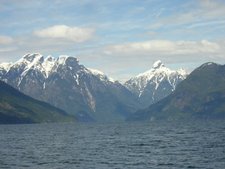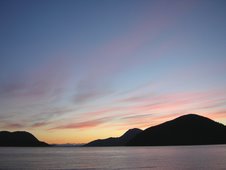
The Greenpeace ship the Esperanza was in Jervis Inlet last week training their crew in one-man mini subs. They will be heading to the Bering Sea to explore some of the deepest underwater canyons in the world over the next two months. I was lucky to get to meet some of their crew members, take pictures and write a story for the local paper the Coast Reporter. Here is my report:
The famous rainbow insignia across her bow is a little worn, but considering the Greenpeace ship, the Esperanza (Spanish for hope), recently finished a 15 month journey following the Japanese whaling fleet around the world, that can be expected.
The ship and crew have come to the deep and protected waters of Jervis Inlet on BC’s Sunshine Coast to train in their new single person submarines. The two subs were designed and built by Nuytco Research Ltd. of North Vancouver and are capable of diving up to 2000 feet.
The Greenpeace crew will be using them to search two of the largest underwater canyons in the world, the Zhemchug and the Pribilof canyons in the Bering Sea. No one has ever been in these canyons. They have only been researched by one remote submersible.
The Esperanza’s crew of 16 will be in the waters off Alaska for two months searching the canyons for sea life with their cameras that also have fixed laser beams to measure distance. These are remote, deep, and highly productive areas. Sea lions, seals and whales make these areas their nursery grounds and foraging areas.
Crew members Clive Strauss, the ship’s doctor, from Victoria and John Hocevar, an ocean specialist, from Austin, Texas, spend some time discussing the goals and plans for this trip. The Greenpeace members are hoping to work with coastal communities to establish marine-cultural heritage zones. Last summer Greenpeace workers completed a listening tour where they met with Native communities to identify their problems and find solutions.
While the ship’s crew explores the underwater canyons, other Greenpeace members will be meeting with fishing dependent communities from Bristol Bay, St. Lawrence, the Aleutians and the Alaska peninsula. Many of the local people of these communities lose out as the large bottom trawlers literally scrape the ocean floor to harvest everything. Most of these vessels are American flagged vessels, but the owners may be based in Tokyo, Norway or Seattle says Hocevar.
“Since so much of the Bering Sea is trawled,” he says, “the deeper areas become refuges for the larger species.”
Alaska has been seen as a model for marine fisheries management. However, they have been unable to prevent decline. That is why Greenpeace sees the need to set aside important areas such as the Zhemchug and Pribilof canyons for protection.
There is a long way to go before people have enough voice over the big money interests says Strauss. They are taking a small step by working with the local people.
The Greenpeace team chose the Jervis Inlet for training because it is quiet, deep and protected. The subs dove to around 900 feet says Hocevar. When diving that deep it is pitch black and you must learn to have confidence in your crew and equipment he says.
During their dives they saw sponges, corals, tiny bright red crabs and a lot of juvenile rock fish. He says he saw some other fish he has never seen before and couldn’t identify.
As they look out over the inlet both men comment on the visible clear cuts and wonder why such logging would be done in this beautiful area. There is a discussion about clear cutting and watersheds when the men are informed of the latest logging controversy in Egmont. Everyone wonders why some sort of sustainable logging cannot be used to manage the forests.
Both Hocevar and Strauss wanted to work with Greenpeace for a long time. Hocevar says he wanted to work with Greenpeace since he was very young. “I sent them my CV when I graduated and again when I got my Masters,“ he laughs. “Finally they called me.”
Strauss has been a member of Greenpeace for many years. He let them know that he would like to be a physician for them and waited for a call. In 1998 he got a call from Amsterdam to join the team at the Great Bear Rainforest, but with only two days notice he couldn’t make it. Another call came for him as an alternate physician in Central America, but the main physician showed and again he didn’t go. After a trip to Somalia with Doctors without Borders he was contacted to join the Greenpeace crew.
They encourage anyone who would like to work with Greenpeace to contact their local office and begin as a volunteer. If you would like to follow the Esperanza and her crew you can view the Greenpeace website at oceans.greenpeace.org/en/ where there is a web cam link.
The famous rainbow insignia across her bow is a little worn, but considering the Greenpeace ship, the Esperanza (Spanish for hope), recently finished a 15 month journey following the Japanese whaling fleet around the world, that can be expected.
The ship and crew have come to the deep and protected waters of Jervis Inlet on BC’s Sunshine Coast to train in their new single person submarines. The two subs were designed and built by Nuytco Research Ltd. of North Vancouver and are capable of diving up to 2000 feet.
The Greenpeace crew will be using them to search two of the largest underwater canyons in the world, the Zhemchug and the Pribilof canyons in the Bering Sea. No one has ever been in these canyons. They have only been researched by one remote submersible.
The Esperanza’s crew of 16 will be in the waters off Alaska for two months searching the canyons for sea life with their cameras that also have fixed laser beams to measure distance. These are remote, deep, and highly productive areas. Sea lions, seals and whales make these areas their nursery grounds and foraging areas.
Crew members Clive Strauss, the ship’s doctor, from Victoria and John Hocevar, an ocean specialist, from Austin, Texas, spend some time discussing the goals and plans for this trip. The Greenpeace members are hoping to work with coastal communities to establish marine-cultural heritage zones. Last summer Greenpeace workers completed a listening tour where they met with Native communities to identify their problems and find solutions.
While the ship’s crew explores the underwater canyons, other Greenpeace members will be meeting with fishing dependent communities from Bristol Bay, St. Lawrence, the Aleutians and the Alaska peninsula. Many of the local people of these communities lose out as the large bottom trawlers literally scrape the ocean floor to harvest everything. Most of these vessels are American flagged vessels, but the owners may be based in Tokyo, Norway or Seattle says Hocevar.
“Since so much of the Bering Sea is trawled,” he says, “the deeper areas become refuges for the larger species.”
Alaska has been seen as a model for marine fisheries management. However, they have been unable to prevent decline. That is why Greenpeace sees the need to set aside important areas such as the Zhemchug and Pribilof canyons for protection.
There is a long way to go before people have enough voice over the big money interests says Strauss. They are taking a small step by working with the local people.
The Greenpeace team chose the Jervis Inlet for training because it is quiet, deep and protected. The subs dove to around 900 feet says Hocevar. When diving that deep it is pitch black and you must learn to have confidence in your crew and equipment he says.
During their dives they saw sponges, corals, tiny bright red crabs and a lot of juvenile rock fish. He says he saw some other fish he has never seen before and couldn’t identify.
As they look out over the inlet both men comment on the visible clear cuts and wonder why such logging would be done in this beautiful area. There is a discussion about clear cutting and watersheds when the men are informed of the latest logging controversy in Egmont. Everyone wonders why some sort of sustainable logging cannot be used to manage the forests.
Both Hocevar and Strauss wanted to work with Greenpeace for a long time. Hocevar says he wanted to work with Greenpeace since he was very young. “I sent them my CV when I graduated and again when I got my Masters,“ he laughs. “Finally they called me.”
Strauss has been a member of Greenpeace for many years. He let them know that he would like to be a physician for them and waited for a call. In 1998 he got a call from Amsterdam to join the team at the Great Bear Rainforest, but with only two days notice he couldn’t make it. Another call came for him as an alternate physician in Central America, but the main physician showed and again he didn’t go. After a trip to Somalia with Doctors without Borders he was contacted to join the Greenpeace crew.
They encourage anyone who would like to work with Greenpeace to contact their local office and begin as a volunteer. If you would like to follow the Esperanza and her crew you can view the Greenpeace website at oceans.greenpeace.org/en/ where there is a web cam link.






